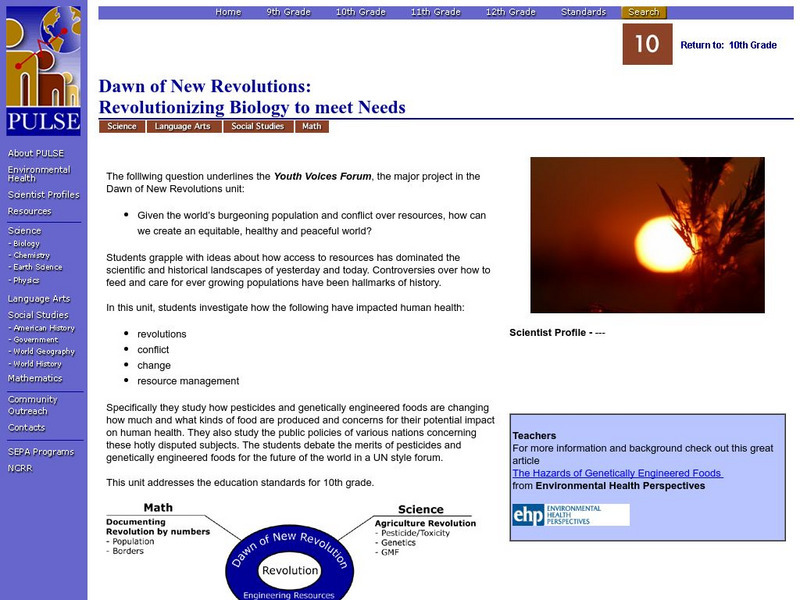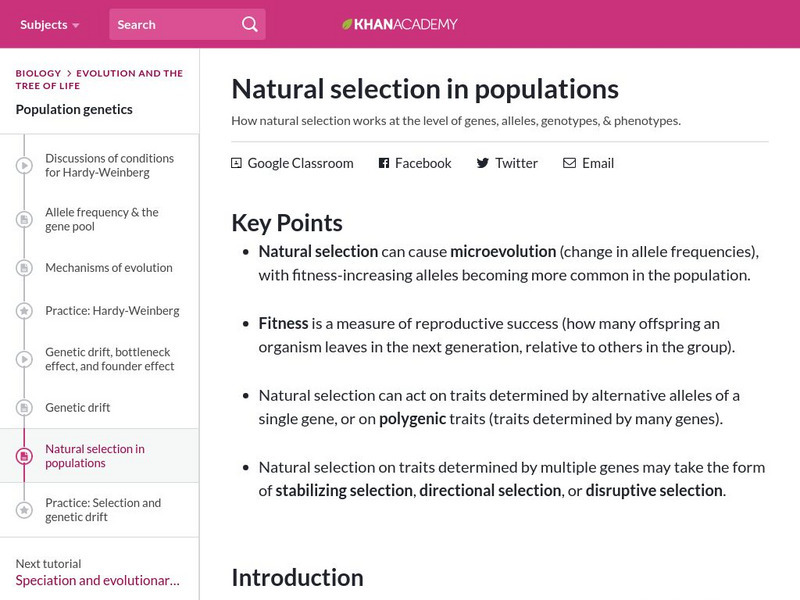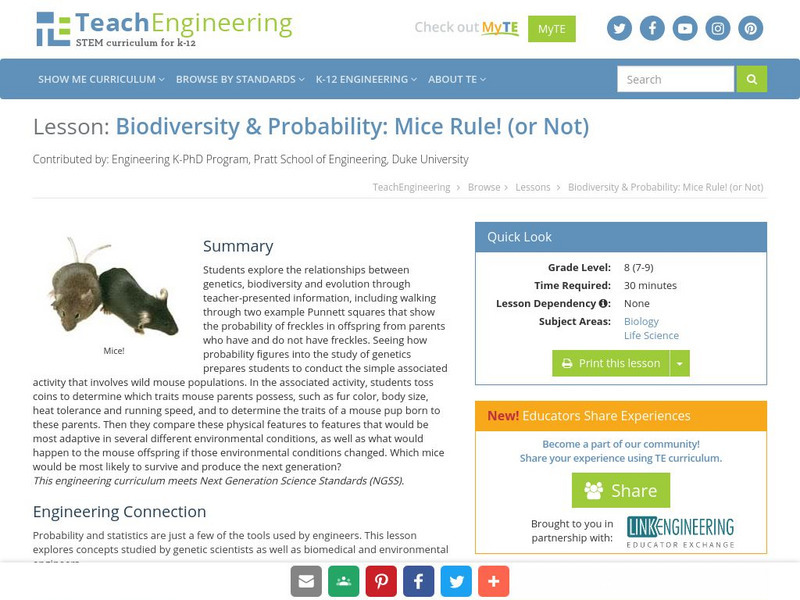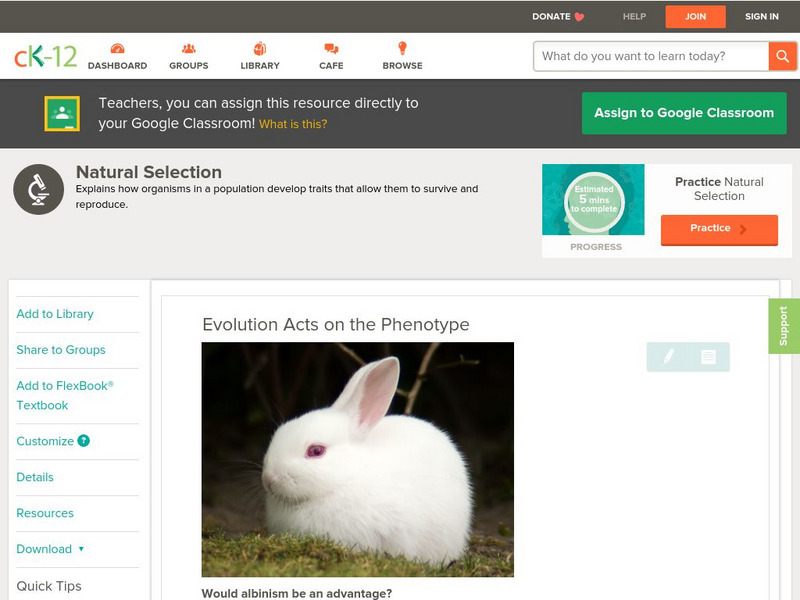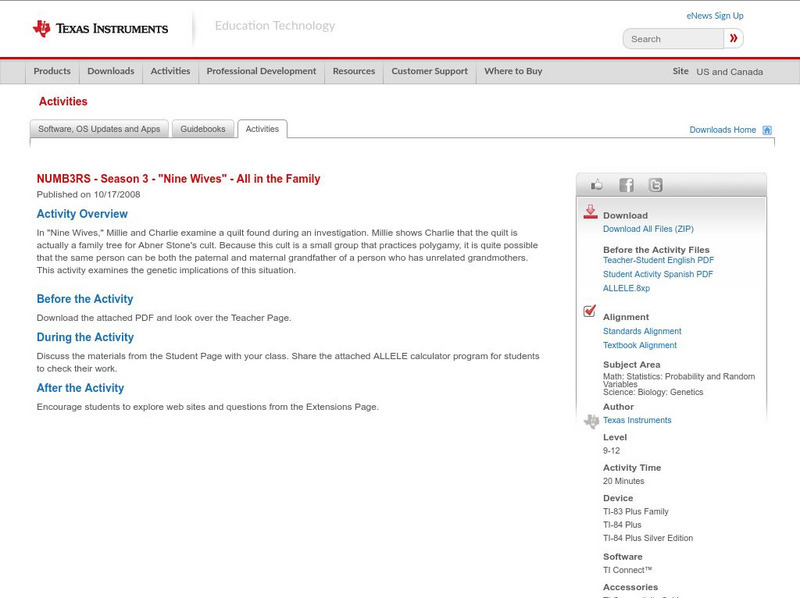CK-12 Foundation
Ck 12: Biology: Forces of Evolution
[Free Registration/Login may be required to access all resource tools.] Describes three of the four forces of evolution: mutation, gene flow, and genetic drift.
University of Arizona
Pulse: Dawn of New Revolutions
A cross curricular unit focusing on how much and what kinds of foods are produced because of pesticides and genetically engineered foods. Students will investigate the impact on humans due to the new technology in food production. Topics...
Khan Academy
Khan Academy: Natural Selection in Populations
How natural selection works at the level of genes, alleles, genotypes, & phenotypes.
National Health Museum
Access Excellence: Molecular Biology/primate Phylogeny
This lesson plan involves comparison of amino acids to create a phylogenetic tree of primates. Students will also use other species information to draw conclusions about evolutionary relationships.
Other
Evolution: The Theory of Natural Selection (Part 1)
These pages are part of a site called Evolution that accompany a textbook by the same name. Mark Ridley is the author. This section has an advanced discussion of determining allele and genotype frequencies using the Hardy-Weinberg ratio.
National Health Museum
Nhm: Amino Acid Sequences Show Evolution
This lesson plan focuses on differences in the amino acid sequence of hemoglobin and myoglobin proteins. They use the number of differences to create a phylogenetic tree.
National Health Museum
Access Excellence: Making a Phylogenetic Tree Lesson Plan
Constructing phylogenetic trees may be a daunting task for students, but this lesson plan is a simulation of what molecular biologists must do to determine relationships. This plan is for students who have a good grasp of DNA structure...
National Health Museum
Nhm: Restriction Maps to Cladograms Lesson
This lesson plan requires students to analyze DNA restriction maps to determine the differences in the sequence for several primates and humans. They then use the information to create a cladogram.
Estrella Mountain Community College
Online Biology Book: The Modern View of Evolution
Take a closer look into the modern view of evolution. This article includes many pieces of evidence, all which support the theory of evolution.
TED Talks
Ted: Ted Ed: Why Are Some People Left Handed?
Today, about one-tenth of the world's population are southpaws. Why are such a small proportion of people left-handed -- and why does the trait exist in the first place? The following video investigates how the uneven ratio of lefties...
PBS
Pbs Teachers: Nordic Sagas: Iceland Genes
Explain how the isolated and homegeneous population of Iceland makes research in family ancestry simpler than in other cultures. Investigate the work of genealogists, and trace your own heritage as far as you can without extensive research.
Palomar Community College District
Palomar College: Hardy Weinberg Principle
This site from Palomar College describes the conditions needed for theHardy-Weinberg Principle to hold true.Completes sample calculations involvingthis principle.
TeachEngineering
Teach Engineering: Mice Rule! (Or Not)
Students explore the relationships between genetics, biodiversity, and evolution through a simple activity involving hypothetical wild mouse populations. First, students toss coins to determine what traits a set of mouse parents...
University of Hamburg
University of Hamburg: The Hardy Weinberg Equilibrium
Discusses the historical background leadingto the development of the Hardy-Weinberg principleand the assumptions of the principle. Providesmathematical and graphical illustrations ofthis principle.
BiologyWise
Biology Wise: Crossing Over and Why Is It Important in Meiosis?
Explains what meiosis is and what happens during crossing over where genetic material is exchanged between chromosomes. This process is important for ensuring that there is lots of genetic variation in a population as it improves survival.
Cosmo Learning
Cosmo Learning: Principles of Evolution, Ecology and Behavior
A collection of video lectures introducing beginning biology students to the principles of evolution, ecology, and behavior. The course was taught three times a week for a semester at Yale University. The course discusses concepts of...
Khan Academy
Khan Academy: Allele Frequency & the Gene Pool
Learn how to find allele frequency and how it's different from genotype frequency.
CK-12 Foundation
Ck 12: Life Science: Evolution Acts on the Phenotype
[Free Registration/Login may be required to access all resource tools.] Natural selection acts on the phenotype (traits or characteristics) of an individual. On the other hand, natural selection does not act on the underlying genotype...
Center for Educational Technologies
Earth Science Explorer: Diversity
Written for younger students, this site explains biodiversity and links to easy to understand explanations of species and genetic diversity.
BiologyWise
Biology Wise: A Detailed List of Human Races
Describes the four broad categories of human races in the world, their geographical origins, and their sub-types. Also discusses the difficulties of tracing all branches of a race throughout human history, which is even more so today...
National Health Museum
Access Excellence: Hardy Weinberg Equilibrium
This site explores what Hardy-Weinberg Equilibrium is, and how teachers can explore this topic in their classrooms. Content includes background information on this topic, as well as numerous learning activities.
Texas Instruments
Texas Instruments: Numb3 Rs: All in the Family
Based off of the hit television show NUMB3RS, this lesson shows students the scientific reasoning behind the societal taboo of incest. Students complete a Punnett square to determine the chances of an offspring inheriting two recessive...
CK-12 Foundation
Ck 12: Biology: Hardy Weinberg Theorem
[Free Registration/Login may be required to access all resource tools.] Introduces Hardy-Weinberg equilibrium.
Palomar Community College District
Palomar College: Gene Flow
This site from Palomar college explains what gene flow is and describes a situation where this occurs in humans. Information is brief but factual.
Other popular searches
- Population Genetics 11 Grade
- Population Genetics Bunnies
- Population Genetics Lab
- Population Genetics Rabbit



